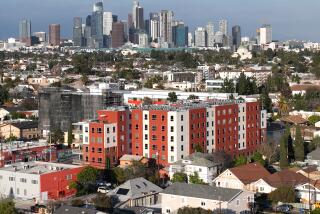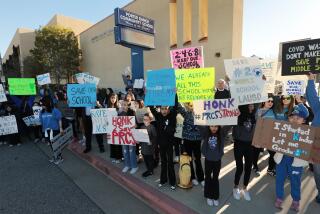University’s ‘Leap of Faith’ Becomes Lesson in Community
WORCESTER, Mass. — Academic miracles were a hard sell when Donna Rodrigues went door to door in the grim area she grew up in, recruiting students for a new public high school.
But six years later, as University Park Campus School prepares to graduate its first senior class, the unusual partnership between a small private university and its hardscrabble city neighborhood has emerged as a vehicle for community transformation -- and a symbol of hope.
Although most came from homes where no English was spoken -- and all from desperately poor families -- the school’s 30 12th-graders sailed through a tough state achievement test and plan to attend college. About half have applied to Clark University, which promised full scholarships to qualified graduates.
“This defeats the literature,” said University Park history teacher Ricci Hall, who signed on as a student teacher from Clark University six years ago and never left. “These kids are beating the odds.”
Clark officials proposed the idea to the city school district, offering funds, teachers and other support to make University Park a reality. It opened its doors in 1997 in a long-vacant elementary school across the street from the university.
Since then, officials say, crime and transiency have gone down in the one-square-mile area known as Main South, and residential occupancy is up. Some families say they have moved in just so their children can attend University Park.
Delegates from dozens of other urban colleges have visited University Park to study its strategy. As colleges around the country struggle to thrive in poor urban areas, some education experts cite the small high school’s success as a model.
The school was born after Clark and Main South spent years eyeing each other with mutual unease -- so much so that Clark officials talked seriously about moving the century-old liberal arts institution to a rural area.
“But to ignore your neighborhood is hypocritical; you can’t do that,” said Jack Foley, executive assistant to Clark President John Bassett. “You’ve got to take fences down and strengthen your neighborhood.”
Fueled by what Foley called “enlightened self-interest,” the university reached out, launching a collaboration almost two decades ago to revitalize an area that once was home to proud Victorians and prosperous tradesmen.
But rehabilitated housing, federal funds and good intentions were not enough. University administrators worried that Clark could not maintain an undergraduate population of about 2,000 if Main South continued to deteriorate.
Rethinking their approach, Clark officials decided a school could serve as “the centerpiece for neighborhood stability,” said Tom Del Prete, director of Clark’s Hiatt Center for Urban Education. Del Prete knew of no comparable teaming of a private university and a public school district, and no other university that guaranteed free tuition to such a large crop of local residents.
Though the undertaking was “an academic leap of faith,” he said, Clark leaders “had faith in the kids and faith in the neighborhood. We knew that good schools anchor people’s commitment to a community.”
But the smartest move of all, Foley and others said, was hiring Rodrigues to run the new school.
An educator for 34 years, Rodrigues grew up in Main South, raised her family there and taught many parents of students she now mentors as principal.
Tenacious, supremely determined and armed with a master’s degree from Harvard University, Rodrigues envisioned a school with small classes, long hours and high expectations. She decreed that all University Park students would succeed.
The edict has worked, said language arts teacher June Eressy, “because no one wants to let Donna down.”
A sturdy woman in her mid-50s, Rodrigues banned street talk and bullying. As she welcomed students, she informed them that disrespect would have no place at University Park.
“Mrs. Rodrigues, she is real persistent,” said senior class valedictorian Damian Ramsey. “She gets what she wants, and she makes you want to do your best.”
A majority of the first students came from homes where no English was spoken. Sixty percent were minorities -- largely black, Latino and Vietnamese.
Most families earned less than $20,000 a year. Three-quarters qualified for free or subsidized lunches. The average reading level was third grade.
At least one member of the pioneer class, Jovan Pressie, could not read at all until history teacher Hall taught her. Since then, she said, “I never wanted to stop.”
Had she not gone to University Park, Pressie said she probably would have dropped out of school by eighth grade. Instead, she is headed to college.
The seniors boast an attendance rate of 98% -- and dropout, suspension and expulsion rates of zero. Along with Clark and various state schools, students have applied to Boston College, Dartmouth, Brown, Georgetown and Harvard.
The 12th-grade class also made University Park one of a handful of Massachusetts high schools to score 100% passage rates on the state’s demanding mandatory achievement test.
To Rodrigues these results convey a message she said many educators fail to grasp: “You can’t keep taking credit for the top 20% of every class. You have to teach all the other kids. The challenges are these kids, poor and minority kids.”
Wearing long faces as they left the principal’s office recently, three girls offered a glimpse of how her formula succeeds. They had acted up, prompting a summons from Rodrigues. That was all it took.
“They would rather get expelled than have me talk to them,” the principal said.
But Rodrigues conceded that the school’s growing reputation has spurred criticism in some quarters.
Naysayers charge that anyone could achieve such results with small classes and support from a nearby university, she said, and some in the teachers’ union complain about the long hours University Park faculty members routinely put in. Rodrigues said the steady flow of student teachers from Clark also sparks ill will from some public schools.
“We do get criticized,” Rodrigues said, adding that she hears rumors of a bottomless budget that allows University Park to outspend other public schools in Worcester. In fact, she said, the per pupil expenditure is the same, about $6,000 per year. Since that first year, when Rodrigues had to recruit, the word is out and admission is determined by a lottery open to any child residing in the area.
Across the country, colleges have grappled with the problem of how to coexist with a rocky urban area. Many schools made strides by building new community facilities.
In Los Angeles, USC won acclaim with an outreach program that sent more than half of the school’s undergraduates to volunteer in the South-Central area. USC also “adopted” five local schools.
But Clark officials believe their idea of creating a neighborhood school and providing free tuition to qualified students is unique. The prospect of replicating the University Park example elsewhere in the city recently helped Worcester land an $8-million grant from the Carnegie Corp.
“Certainly this partnership is seen as a national model,” said Althea Frazier Raynor, a researcher at Brown University’s Annenberg Institute for School Reform. “It stands out because it is making a specific commitment to help young people, mostly kids of color, in a disadvantaged community. It is giving them opportunities they probably never would have had.”
Leaders in this central Massachusetts city of 160,000 stop short of giving the school sole honors for spearheading the neighborhood rebirth. As executive director of the Main South Community Development Corp. -- the umbrella organization formed among Clark and many groups in Main South -- Stephen Teasdale observed, “In any neighborhood, urban improvement is never going to be just one piece.”
Still, Teasdale said, safety in the area has improved “dramatically.” Homeownership is up; vacancies are down. And, he added, “the very fact that parents from outside this area want to send their kids to this school says something, doesn’t it?”
For Clark, a diverse institution with a low national profile but a respected academic tradition, the University Park experiment already is paying off. Applications are up, and those who reject Clark seldom cite “geography” as the reason.
Incoming faculty also say they are more attracted to the school than in the past, according to Foley.
Bassett, the university president, said the possibility that half of University Park’s seniors will enroll at Clark on full scholarships poses a test to academic altruism.
Tuition at Clark runs about $26,000 a year, and, he noted, “they could all go here for four years -- and this is just the first year. We could be looking at 10 or more of these students every year.”
Yet these students can help generate grants and government assistance for Clark, Bassett said, calling the generosity well worth the price.
As he sorted through applications to Clark and several Ivy League colleges, Damian Ramsey remembered how alien those names sounded when he started at University Park.
“I wasn’t thinking about college,” said Ramsey, who lived in 10 foster homes by the time he was 10 years old.
Ramsey was eventually reunited with his mother, who heard about University Park from Rodrigues and encouraged him to enroll.
While working at a clothing store, Ramsey has maintained a 3.87 grade-point average and, like some of his classmates, already has taken some courses at Clark.
He also has developed a passion for the novels of William Faulkner.
He said he worked so hard “because of what I saw around me. I knew I didn’t want to lead that kind of life. I saw fighting, drugs and violence. I moved around. I got evicted. I didn’t want that type of lifestyle.”
Ramsey has his heart set on Boston College. But he said a Clark sheepskin also would look good on his wall.
More to Read
Sign up for Essential California
The most important California stories and recommendations in your inbox every morning.
You may occasionally receive promotional content from the Los Angeles Times.










